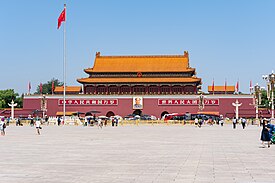
Back Tiananmen-plein Afrikaans ቲያንማን አደባባይ Amharic ساحة تيان آن من Arabic ميدان تيان ان من ARZ Plaza de Tiananmén AST Tyananmen meydanı Azerbaijani Плошча Цяньаньмэнь Byelorussian Плошча Цяньаньмэнь BE-X-OLD Тиенанмън Bulgarian তিয়েনআনমেন চত্বর Bengali/Bangla
| Tiananmen Square | |||||||||||||||||||||||||||||||
|---|---|---|---|---|---|---|---|---|---|---|---|---|---|---|---|---|---|---|---|---|---|---|---|---|---|---|---|---|---|---|---|
 Tiananmen Square in 2020 | |||||||||||||||||||||||||||||||
| Chinese name | |||||||||||||||||||||||||||||||
| Simplified Chinese | 天安门广场 | ||||||||||||||||||||||||||||||
| Traditional Chinese | 天安門廣場 | ||||||||||||||||||||||||||||||
| Hanyu Pinyin | Tiān'ānmén Guǎngchǎng | ||||||||||||||||||||||||||||||
| |||||||||||||||||||||||||||||||
| Manchu name | |||||||||||||||||||||||||||||||
| Manchu script | ᡝᠯᡥᡝ ᠣᠪᡠᡵᡝ ᡩᡠᡴᠠ | ||||||||||||||||||||||||||||||
| Romanization | elhe obure duka | ||||||||||||||||||||||||||||||
Tiananmen Square or Tian'anmen Square (/ˈtjɛnənmən/[1]) is a city square in the city center of Beijing, China, named after the Tiananmen ("Gate of Heavenly Peace") located to its north, which separates it from the Forbidden City. The square contains the Monument to the People's Heroes, the Great Hall of the People, the National Museum of China, and the Mausoleum of Mao Zedong. Mao Zedong proclaimed the founding of the People's Republic of China in the square on October 1, 1949; the anniversary of this event is still observed there.[2] The size of Tiananmen Square is 765 x 282 meters (215,730 m2 or 53.31 acres).[3] It has great cultural significance as it was the site of several important events in Chinese history.
Outside China, the square is best known for the 1989 protests and massacre that ended with a military crackdown due to international media coverage, internet and global connectivity, its political implications, and other factors.[4][5][6] Within China, there is a strict censorship of knowledge of the crackdowns by the Chinese Communist Party.[7]
- ^ "Tiananmen Square". Lexico UK English Dictionary. Oxford University Press. Archived from the original on May 18, 2021.
- ^ The Columbia Encyclopedia, 6th ed
- ^ "Tiananmen Square incident". Britannica. Retrieved 11 February 2021.
- ^ Miles, James (2 June 2009). "Tiananmen killings: Were the media right?". BBC News. Retrieved 3 November 2010.
- ^ "Tiananmen Square protest death toll 'was 10,000'". BBC News. 23 December 2017. Retrieved 3 June 2019.
- ^ "The Truth Behind The Tiananmen Square Massacre - CBS News". www.cbsnews.com. 2009-06-04. Retrieved 2023-06-30.
- ^ Ruan, Lotus; Knockel, Jeffrey; Ng, Jason Q.; Crete-Nishihata, Masashi (December 2016). "One App, Two Systems". figure 9. Archived from the original on 10 October 2019. Retrieved 30 September 2019.